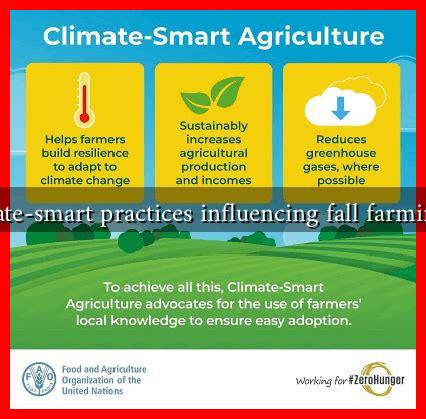-
Table of Contents
How are Climate-Smart Practices Influencing Fall Farming Techniques?
As climate change continues to impact agricultural practices worldwide, farmers are increasingly adopting climate-smart techniques to enhance resilience and sustainability. Fall farming, a critical period for many crops, is being transformed by these innovative practices. This article explores how climate-smart practices are influencing fall farming techniques, highlighting their benefits, challenges, and real-world applications.
The Importance of Climate-Smart Agriculture
Climate-smart agriculture (CSA) refers to an approach that aims to increase productivity while reducing greenhouse gas emissions and enhancing resilience to climate change. The three main objectives of CSA are:
- Increasing agricultural productivity and incomes.
- Adapting and building resilience to climate change.
- Reducing greenhouse gas emissions.
In the context of fall farming, these objectives are crucial as farmers prepare for the winter months and plan for the next growing season. The adoption of climate-smart practices can lead to improved soil health, better water management, and enhanced crop diversity.
Innovative Fall Farming Techniques
Farmers are implementing various climate-smart practices during the fall season, which include:
- Cover Cropping: Planting cover crops such as clover or rye during the fall helps prevent soil erosion, improve soil fertility, and enhance moisture retention. According to the USDA, cover crops can increase soil organic matter by 0.1 to 0.2% per year.
- No-Till Farming: This technique minimizes soil disturbance, preserving soil structure and health. A study published in the journal Soil & Tillage Research found that no-till practices can reduce soil erosion by up to 90% compared to conventional tillage.
- Crop Rotation: Rotating crops in the fall can break pest and disease cycles, improve soil health, and increase biodiversity. For instance, rotating corn with legumes can enhance nitrogen levels in the soil.
- Integrated Pest Management (IPM): Utilizing IPM strategies helps manage pests sustainably, reducing the need for chemical pesticides. This approach can be particularly effective in fall crops, where pest pressure may vary.
Case Studies: Successful Implementation of Climate-Smart Practices
Several farms around the world have successfully integrated climate-smart practices into their fall farming techniques:
- Rodale Institute (USA): This research farm has demonstrated that organic cover cropping and no-till practices can significantly improve soil health and crop yields. Their studies show that organic systems can yield as much as conventional systems while sequestering more carbon.
- Farmers in the Netherlands: Many Dutch farmers have adopted precision agriculture techniques, utilizing data analytics to optimize planting schedules and resource use. This has led to increased efficiency and reduced environmental impact.
- Smallholder Farmers in Kenya: Through the use of agroforestry and intercropping, smallholder farmers have improved their resilience to climate variability. These practices have led to increased food security and income stability.
Challenges and Considerations
While the benefits of climate-smart practices are clear, farmers face several challenges in their implementation:
- Initial Costs: Transitioning to climate-smart practices may require upfront investments in new equipment or seeds.
- Knowledge Gaps: Many farmers may lack access to information or training on climate-smart techniques.
- Market Access: Farmers may struggle to find markets for their sustainably produced crops, limiting their economic viability.
Conclusion
Climate-smart practices are reshaping fall farming techniques, offering farmers innovative ways to enhance productivity while addressing the challenges posed by climate change. By adopting practices such as cover cropping, no-till farming, and integrated pest management, farmers can improve soil health, increase resilience, and contribute to a more sustainable agricultural system. However, overcoming challenges related to costs, knowledge, and market access is essential for widespread adoption. As the agricultural sector continues to evolve, the integration of climate-smart practices will play a pivotal role in ensuring food security and environmental sustainability.
For more information on climate-smart agriculture, visit the FAO’s Climate-Smart Agriculture page.


